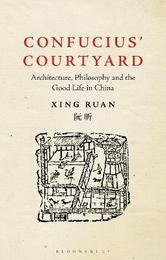
|
Confucius' Courtyard: Architecture, Philosophy and the Good Life in China
Hardback
Main Details
| Title |
Confucius' Courtyard: Architecture, Philosophy and the Good Life in China
|
| Authors and Contributors |
By (author) Xing Ruan
|
| Physical Properties |
| Format:Hardback | | Pages:368 | | Dimensions(mm): Height 216,Width 138 |
|
| Category/Genre | History of architecture
Asian and Middle Eastern history |
|---|
| ISBN/Barcode |
9781350217621
|
| Classifications | Dewey:720.103 |
|---|
| Audience | | Tertiary Education (US: College) | |
|---|
| Illustrations |
61 bw illus
|
|
Publishing Details |
| Publisher |
Bloomsbury Publishing PLC
|
| Imprint |
Bloomsbury Visual Arts
|
| Publication Date |
18 November 2021 |
| Publication Country |
United Kingdom
|
Description
For more than three thousand years, Chinese life - from the city and the imperial palace, to the temple, the market and the family home - was configured around the courtyard. So too were the accomplishments of China's artistic, philosophical and institutional classes. Confucius' Courtyard tells the story of how the courtyard - that most singular and persistent architectural form - holds the key to understanding, even today, much of Chinese society and culture. Part architectural history, and part introduction to the cultural and philosophical history of China, the book explores the Chinese view of the world, and reveals the extent to which this is inextricably intertwined with the ancient concept of the courtyard, a place and a way of life which, it appears, has been almost entirely overlooked in China since the middle of the 20th century, and in the West for centuries. Along the way, it provides an accessible introduction to the Confucian idea of zhongyong ('the Middle Way'), the Chinese moral universe and the virtuous good life in the absence of an awesome God, and shows how these can only be fully understood through the humble courtyard - a space which is grounded in the earth, yet open to the heavens. Erudite, elegant and illustrated throughout by the author's own architectural drawings and sketches, Confucius' Courtyard weaves together architecture, philosophy and cultural history to explore what lies at the very heart of Chinese civilization.
Author Biography
Xing Ruan is Dean and Guangqi Chair Professor of Architecture at the School of Design, Shanghai Jiao Tong University, China.
Reviews[Confucius' Courtyard] is a delightful reflection on and exposition of the significance of the courtyard to the Chinese conceptualization of the cosmos and way of life ... Ruan elegantly weaves together literary, philosophical, artistic and architectural musings. The book is both learned and readable. * Times Literary Supplement * What can I say? This is a truly magnificent work of scholarship for the understanding of China, one that I have been waiting for - China as a civilization at the centre of which is the courtyard: an architectural feature that embodies the doctrine of the mean set in a material world, compact enough to be readily accessible to reason and lived with due deference to the social rites and rules under Heaven's benign patronage, a world that modern society has vigorously transgressed in recent decades, leading us to wonder, what follows? Unlike many scholarly books Xing Ruan's comes to life, almost jumps off the page, because it draws not only on traditional sources in history and philosophy, but also on charming narratives of how the Chinese people actually lived. It is a book for the scholar's study and for the hammock by the seashore. It is a triumph that I envy! * Yi-Fu Tuan, J.K. Wright and Vilas Professor Emeritus of Geography, University of Wisconsin * An enchanting story paradoxically woven round a void - the courtyard - it offers a fresh account of the transformations of the Chinese city. * Joseph Rykwert, Paul Philippe Cret Professor Emeritus of Architecture, University of Pennsylvania * Xing Ruan grasps a fundamental architectural element as an insightful window for understanding broader issues of society and history. Ruan's elegant prose soars as he weaves nuanced observations, classical Chinese writings, and buildings throughout the world into a cohesive narrative. * Ronald G. Knapp, SUNY Distinguished Professor Emeritus, State University of New York New Paltz * This humane and intelligent study compares courtyard buildings of widely different ages and geographies. Deep insight into architectural world-building is the result. Apparently empty, the courtyard is full of potential, actualized historically in ways that still make sense, even today. * David Leatherbarrow, Professor of Architecture, University of Pennsylvania *
|